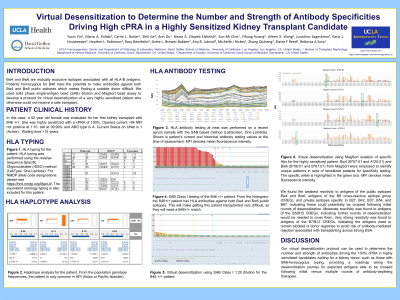Back

Virtual Desensitization to Determine the Number and Strength of Antibody Specificities Driving High cPRA in a Highly Sensitized Kidney Transplant Candidate
(P412) Virtual desensitization to determine the number and strength of antibody specificities driving High cPRA in a highly sensitized kidney transplant candidate
Location: Platinum Ballroom

Poster Presenter(s)
Body: Patients homozygous for B46 have the potential to make antibodies against both Bw4 and Bw6 public epitopes which makes finding a suitable donor difficult. Here, we report a case of a 51-year-old B46-homozygous female being evaluated for her first kidney transplant at our center with wait time of over 15 years. We performed SAB with titrations along with the cutting-edge MagSort bead assay, and surrogate flow cytometry crossmatches (FCXM) to determine and confirm the number and strength of antibody specificities driving the high cPRA and assess the potential for successful desensitization allowing the patient to cross antibodies reduced in titer. We found the weakest reactivity to antigens of the public epitopes Bw4 and Bw6, antigens of the B8 cross-reactive epitope group (CREG), and private epitopes specific to B27, B42, B37, B54, and B67, indicating these could potentially be crossed following initial rounds of desensitization. Moderate reactivity was found to antigens of the B5/B15 CREGs, indicating further rounds of desensitization would be needed to cross them. Very strong reactivity was found to antigens of the B7/B12 CREGs, indicating these antigens need to remain blocked in donor registries to avoid risk of antibody-mediated rejection associated with transplanting across strong DSA.
Conclusion: Our virtual desensitization protocol can be used to determine the number and strength of antibodies driving the 100% cPRA in highly sensitized candidates waiting for a kidney donor, such as those with B46-homozygous typing, providing a roadmap along the desensitization journey for expected antigens able to be crossed following initial versus multiple rounds of antibody-depleting therapies.
Conclusion: Our virtual desensitization protocol can be used to determine the number and strength of antibodies driving the 100% cPRA in highly sensitized candidates waiting for a kidney donor, such as those with B46-homozygous typing, providing a roadmap along the desensitization journey for expected antigens able to be crossed following initial versus multiple rounds of antibody-depleting therapies.

